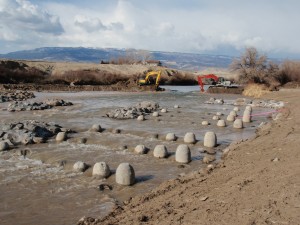Making rivers whole again
I was reminded the other day of just how big of an impact a single TU reconnect project can have on an entire river watershed. Consider that a recently completed fish passage on an old diversion dam on Wyoming's Greybull River opened up 100 miles of habitat to trout, for the first time in 80 years! That's right -- 100 miles. (See the fish ladder pic at left.) TU's Wyoming Water Project team led the collaborative effort, in partnership with the U.S. Fish and Wildlife Service and the Wyoming Wildlife and Natural Resource Trust. As WWP Director Cory Toye said in this article, "The Greybull above and below this dam is considered two of the best Yellowstone cutthroat populations left in the state. It's one of the best strongholds we have, and this will further secure that and make it better." By removing this barrier, the river system and its habitat will be made whole, allowing downstream fish to access important upstream spawning and rearing tributaries for the first time in over half a century.
Likewise, in Colorado, the Hartland Diversion Dam once posed a formidable barrier to both boaters and fish on the stretch of the Gunnison River between Paonia and Grand Junction. But TU, in partnership with the U.S. Fish and Wildlife Service, Painted Sky Resource, Conservation and Development Council, and other public and private stakeholders, recently completed a fish (and boat) passage by removing the dam and replacing it with scores of raised cones that break up and slow down the flows, allowing fish passage up- and down-stream. For anglers and boaters, a special chute also makes for an uninterrupted 68-mile float, for the first time in decades.
The reconstructed dam structure “expands the river available to anglers but the main intention is to protect native river fish in the Gunnison River and reconnect two populations,” TU project coordinator Cary Denison told the Grand Junction newspaper.
Multiply these projects by scores of others, and you get a sense of the kind of impact TU and its partners are making on the ground, with landscape-scale habitat improvements and increased opportunity for anglers and other river recreationists.
Making rivers whole again -- now that's an exciting and lasting legacy.




